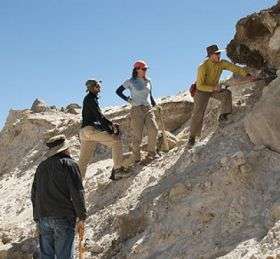Professor talks about latest in Younger Dryas work in Science article

University of Cincinnati Professor of Geology Tom Lowell is featured in the July 18 issue of Science, discussing the latest research into the question of whether the significant climate change event about 12,900 years ago known as Younger Dryas impacted the climate all around the globe.
The Younger Dryas event refers to an unexpected rapid cooling of the earth that is known to have lasted about 1,300 years. It coincided with widespread extinctions of species, but, although the event itself is well-documented, scientists are still unclear of whether its impact was felt equally all across the globe.
The extent of the impact in the Southern Hemisphere is, in particular, unresolved.
Lowell has researched evidence of historical climate change all over the globe, including significant amounts of research south of the equator. Just this month, he has returned from a month-long expedition to Peru, where he and colleagues took samples near the Quelccaya Ice Cap.
One of the purposes of this most recent trip corresponds with the central question that Lowell has written about in Science: Why are there discrepancies in results being returned from two primary dating techniques, and what does that say about understanding Younger Dryas and other major climate change events?
"The whole point is that this was a time of rapid environmental transition that we do not understand the cause for," says Lowell. "One of the primary things you have to understand before you can attribute cause is how widespread the event was. That's a question my work in the Southern hemisphere has been associated with.
"It just might be that we don't have the necessary dating techniques to make these determinations."
Lowell is an expert in the use of radiocarbon dating techniques. His co-author in the Science piece (as well as colleague on the Peru expedition), Meredith Kelly from the Lamont-Doherty Earth Observatory, is expert in a more recently developed dating technique called surface-exposure dating, which can be obtained from boulders left behind in glacial moraines.
There are only a handful of known locations in the Southern hemisphere (one of which is Quelccaya) where samples for both kinds of testing can be obtained at the same site.
When previous sampling has been done at locations in New Zealand and Argentina, there has been conflict in the dating of the Younger Dryas event between the two techniques. Radiocarbon dating has shown that glacial advances happened prior to Younger Dryas, but surface-exposure dating indicates that glacial movement happened at the end of Younger Dryas.
That leaves scientists to ponder two likely explanations, Lowell and Kelly write in Science. The first is that the evidence being obtained through the two dating techniques are looking at two different stratified levels of samples, with the carbon-based samples likely dating back to the beginning of Younger Dryas and the advance of the glaciers and the surface-exposure samples coming from a time at the end of Younger Dryas, when the glaciers retreated.
The second option is that there could be problems in calibrating the dating techniques themselves against each other.
To test the second possibility, they undertook the recent trip to Peru.
Lowell and Kelly are also collaborating on this work with Fred Phillips, a professor of hydrology at New Mexico Tech whom Lowell describes as one of the godfathers of the surface-exposure dating process.
Also among those on the seven-member crew that made the trip to the 16,000-foot elevation in Peru were two former UC students: Colby Smith, who just finished work on his PhD in Geology, and former UC undergrad Patrick Applegate, who is now pursuing his PhD at Penn State.
Answering this question has significant implications for better understanding Younger Dryas. New work also published in this edition of Science by a team led by Robert P. Ackert from the Woods Hole Oceanographic Institution supports the conclusion that the forces causing the Younger Dryas event did not cool the eastern glaciers in the Patagonian Icefields in southern Argentina.
This finding, in conjunction with previous findings from the ice cores in Greenland and Antarctica that show that Greenland cooled during Younger Dryas while Antarctica warmed, support the theory that Younger Dryas did not have much impact farther south than the Tropics.
"We were at (Quelccaya) two years ago for preliminary work where we found evidence of this discrepancy between the two dating systems was present," says Lowell. "This year, our effort was to obtain even more chronological data, so we could assess this problem and try to bring these techniques into compliance with each other."
Source: University of Cincinnati




















